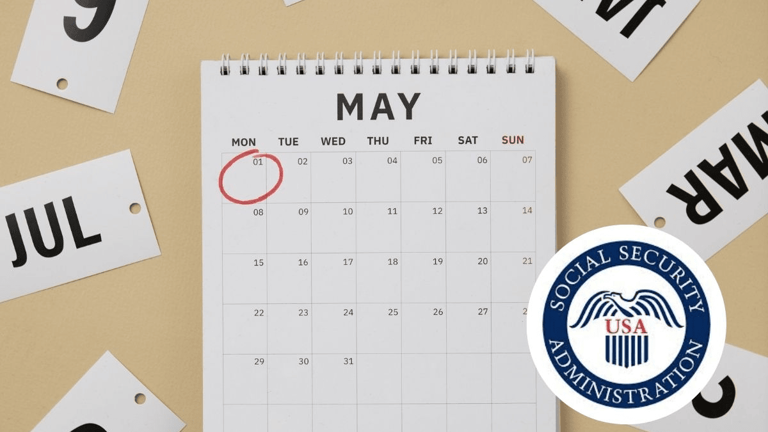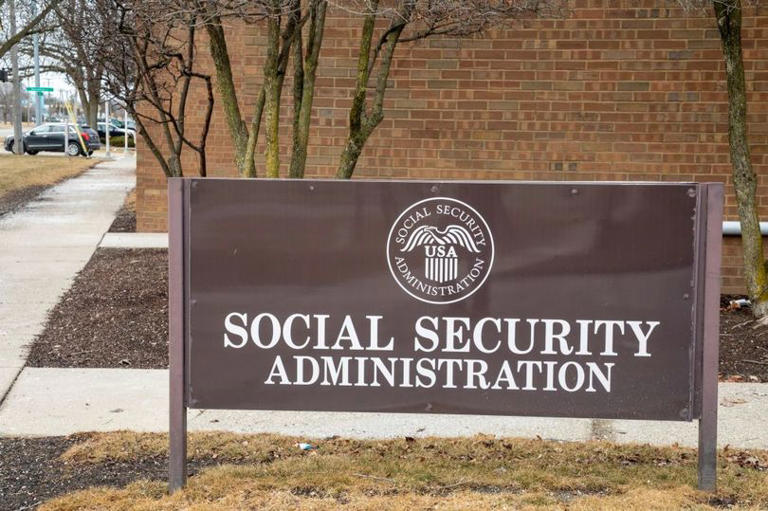A calendar quirk is set to benefit certain Supplemental Security Income (SSI) recipients this May. Due to the way the calendar falls in 2025, some individuals can expect to receive two SSI checks in May instead of the usual one.
This anomaly occurs because June 1, the day the June check is usually scheduled, falls on a weekend. As a result, SSI recipients will receive one check on May 1 and another on May 30.

This adjustment in the Social Security May payment schedule is crucial for recipients to budget accordingly.
Key Takeaways
- SSI recipients will receive two checks in May 2025 due to a calendar quirk.
- The second check on May 30 is an advance payment for June.
- This anomaly is caused by June 1 falling on a weekend.
- Affected recipients should adjust their budget accordingly.
- The usual SSI payment schedule will resume in July.
Understanding the May 2025 Social Security Payment Anomaly
In May 2025, a unique calendar quirk will result in an extra Social Security payment for certain beneficiaries. This anomaly occurs due to the way the Social Security Administration (SSA) schedules payments. Understanding this quirk is crucial for beneficiaries to manage their finances effectively.
The Calendar Quirk Explained
The SSA’s calendar is the reason behind the double deposit. Since June 1, 2025, falls on a Sunday, the SSA will send June’s payment on Friday, May 30, 2025. This means that SSI recipients will receive two checks in May – one on May 1 and another on May 30. This calendar quirk is not new but is an important consideration for beneficiaries to plan their finances accordingly.
Which Beneficiaries Will Receive Extra Payments
SSI recipients are the ones who will receive an extra payment in May 2025. The SSA’s rule is to pay SSI benefits on the first day of the month, unless that day is on a weekend or holiday, in which case the payment is made on the preceding business day. For May 2025, the payment on May 1 is followed by another on May 30, due to June 1 being on a Sunday. This results in two payments being made in May.
- SSI recipients will get two payments in May 2025.
- The extra payment is due to the calendar quirk.
- Beneficiaries should plan their finances accordingly.
SSI Recipients Will Get Two Checks in May 2025
SSI recipients are in for a pleasant surprise in May 2025 as they will receive not one, but two checks. This anomaly in the payment schedule is due to the way the Social Security Administration (SSA) handles payments when the first day of the month falls on a weekend or holiday.
Why SSI Payments Are Affected
The SSA has a rule to send payments early when the first day of the month is on a weekend or holiday. Since June 1, 2025, falls on a Sunday, the SSA will issue the June payment on May 31, 2025, which is a Saturday, but because it’s not a weekday, the payment will be made on the preceding Friday, May 30. As a result, SSI recipients will receive their regular May payment and the advance payment for June in the same month.
This adjustment ensures that beneficiaries receive their payments on time, even when the first day of the month is not a business day. It’s essential for recipients to understand that the second payment is not extra money but an advance for the following month.
Historical Precedents for Double Payments
This is not the first time SSI recipients have received double payments. Earlier in 2025, similar adjustments were made in February and March. The SSA follows the same rule for other months as well, meaning that if a payment date falls on a weekend or holiday, it will be issued on the preceding business day. For the year 2025, aside from May, August and October are also expected to have double payments due to the same scheduling rule.
Beneficiaries should be aware of these adjustments to manage their finances effectively. Understanding the SSA’s payment schedule can help recipients plan their budgets and avoid any confusion when they receive double payments in certain months.

The Complete Social Security May Payment Schedule
The May payment schedule for Social Security benefits is determined by the recipient’s birthdate and the type of benefit they receive.
For non-SSI Social Security recipients, the payment date is based on their birthdate. This means that the payment schedule varies across the month.
Payment Dates Based on Birthdate
- For birthdays between the 1st and 10th, payments are made on May 14.
- For birthdays between the 11th and 20th, payments are made on May 21.
- For birthdays between the 21st and 31st, payments are made on May 28.
Special Schedule for SSI Recipients
SSI recipients receive their payments on different dates. They will receive payments on May 1 and May 30. This is because SSI payments are typically made on the 1st of each month, and when the 1st falls on a weekend, the payment is made on the preceding Friday. However, in May, the second payment is made on May 30, as June 1 is a Sunday.
It’s essential for beneficiaries to be aware of these dates to plan their finances accordingly.
When Will Social Security Checks Be Sent in May? What to Know About 2025 Payment
Social Security recipients can expect their payments in May 2025 according to a predetermined schedule. The Social Security Administration (SSA) follows a specific calendar to ensure that beneficiaries receive their checks on time.
The payment schedule for May 2025 is particularly important for recipients who rely on these funds for their living expenses. Understanding when these payments will be made can help beneficiaries plan their finances more effectively.
Direct Deposit Timeline
For recipients who have opted for direct deposit, the SSA typically processes payments on specific Wednesdays. In May 2025, non-SSI recipients can expect their payments on:
- May 14
- May 21
- May 28
These dates are based on the recipient’s birthdate, as per the SSA’s scheduling rules. Direct deposit is generally the fastest way to receive payments, as it eliminates the wait for paper checks to be delivered.
Paper Check Delivery Estimates
For those who still receive paper checks, the delivery timeline may vary based on the recipient’s location. Generally, the SSA mails checks a few days before the official payment date. However, delivery times can be affected by postal service efficiency.
Recipients can expect their paper checks to arrive around the same time as the direct deposit payments, give or take a few days. It’s essential for beneficiaries to be aware of these timelines to manage their finances effectively.

To ensure timely receipt of their payments, recipients are encouraged to consider switching to direct deposit if they haven’t already done so. The SSA’s online portal or local offices can facilitate this change.
How the Social Security Payment Calendar Works
Understanding the Social Security payment calendar is crucial for beneficiaries to manage their finances effectively. The SSA’s payment calendar is designed to ensure timely distribution of Social Security benefits based on the type of benefit and the recipient’s birthdate or eligibility status.
Regular Payment Scheduling Rules
The SSA follows specific rules for scheduling payments. For non-SSI recipients, payments are made on Wednesdays based on their birthdate. The payment schedule is as follows:
- Birthdates between 1st and 10th: Second Wednesday of the month
- Birthdates between 11th and 20th: Third Wednesday of the month
- Birthdates between 21st and 31st: Fourth Wednesday of the month
SSI payments, however, are typically made on the 1st of the month.
Exceptions and Adjustments to the Schedule
Exceptions occur when the 1st of the month falls on a weekend or holiday. In such cases, SSI payments are made on the preceding business day. For example, if the 1st is a Sunday, the payment will be made on the preceding Friday. This adjustment ensures that beneficiaries receive their payments as early as possible.
The Full 2025 Social Security Payment Schedule
Understanding the 2025 Social Security payment calendar is essential for beneficiaries to plan their finances effectively. The Social Security Administration has outlined the payment dates for both regular benefits and Supplemental Security Income (SSI) payments throughout the year.
Monthly Payment Dates for Regular Benefits
For regular Social Security benefits, the payment dates are determined by the recipient’s birthdate. Beneficiaries born between the 1st and 10th receive their payments on the second Wednesday of each month. Those born between the 11th and 20th receive payments on the third Wednesday, and those born between the 21st and 31st receive payments on the fourth Wednesday.
| Birthdate Range | Payment Date |
|---|---|
| 1st – 10th | Second Wednesday |
| 11th – 20th | Third Wednesday |
| 21st – 31st | Fourth Wednesday |
SSI Payment Calendar for 2025
SSI recipients can expect their payments on the 1st of each month, unless the 1st falls on a weekend or holiday, in which case the payment is made on the preceding business day. Notably, in 2025, SSI recipients will receive double payments in May, August, October, and December due to calendar quirks.
The full 2025 Social Security payment schedule is designed to help beneficiaries plan their finances throughout the year. By understanding the payment dates for both regular benefits and SSI payments, recipients can better manage their budgets and financial obligations.
Why Some Months Have Double SSI Payments
The Social Security Administration (SSA) has a unique payment schedule that can result in double SSI payments during certain months. This phenomenon occurs due to the SSA’s adjustments for weekends and holidays.
Weekend and Holiday Adjustments
When the first day of the month falls on a weekend or a federal holiday, the SSA makes adjustments to ensure timely payments. For instance, if the first day of the month is a Sunday, the SSA will make the payment on the preceding Friday. This can lead to a situation where beneficiaries receive their payment for the current month on the last day of the previous month, and then receive their payment for the next month on the first day of that month, resulting in double SSI payments within a short period.
Impact on Beneficiaries’ Budgeting
The occurrence of double SSI payments can significantly impact beneficiaries’ budgeting. While receiving extra funds might seem beneficial, it can disrupt monthly financial planning. Beneficiaries need to be aware of these adjustments to manage their finances effectively, ensuring they can cover expenses during months when they might receive only one payment or plan accordingly for the extra funds received during double payment months.
To mitigate potential budgeting challenges, beneficiaries should stay informed about the SSA’s payment schedule and plan their expenses accordingly. This includes being aware of months when double payments are likely to occur and adjusting their spending habits to accommodate the irregularity.

Supplemental Security Income: Program Basics
The Supplemental Security Income (SSI) program is a vital source of financial assistance for millions of Americans. Administered by the Social Security Administration (SSA), SSI provides essential support to individuals with disabilities, blindness, or those aged 65 and older, who have limited income and resources.
Eligibility Requirements
To qualify for SSI, applicants must meet specific eligibility criteria. Income and resource limits are key factors in determining eligibility. The SSA considers various types of income, including wages, pensions, and Social Security benefits. Resources, such as cash, stocks, and bonds, are also evaluated. Applicants must also meet the SSA’s definition of disability or be 65 or older.
As stated by the SSA, “eligibility is determined based on income, resources, and disability or age status.” This emphasizes the importance of understanding the eligibility criteria.
Benefit Calculation Methods
The calculation of SSI benefits involves assessing the recipient’s income and living arrangements. The SSA uses a complex formula to determine the benefit amount, considering factors such as federal benefit rates, state supplements, and income exclusions. Understanding how these factors interplay is crucial for recipients to maximize their benefits.

Differences Between SSI and SSDI Payment Schedules
SSI and SSDI, while both vital SSA programs, have distinct payment schedules that beneficiaries should be aware of. Understanding these differences is crucial for managing expectations and finances effectively.
SSDI Payment Dates
SSDI payment dates are determined based on the recipient’s birthdate. The SSA follows a specific schedule where payments are made on different Wednesdays of the month depending on the birthdate.
| Birthdate Range | Payment Date |
|---|---|
| 1st – 10th | Second Wednesday |
| 11th – 20th | Third Wednesday |
| 21st or later | Fourth Wednesday |
How SSI Scheduling Differs
In contrast, SSI payments are typically made on the 1st of the month. However, if the 1st falls on a weekend or holiday, payments are made on the preceding business day.
For example, if July 1st is a Sunday, SSI payments for July will be made on June 28th (Friday).
Managing Your Finances with Irregular Payment Schedules
Managing finances effectively is crucial for Social Security beneficiaries, especially when faced with irregular payment schedules. Beneficiaries must be adept at handling their financial resources to ensure they can meet their needs throughout the month.

Budgeting Tips for Double Payment Months
During months when beneficiaries receive double payments, it’s essential to budget carefully to make the most of the extra funds. Creating a budget that accounts for the irregular influx of money can help ensure that the funds are utilized effectively. Beneficiaries should consider setting aside a portion of the extra payment for months when they might not receive a payment.
Additionally, beneficiaries can benefit from prioritizing their expenses and making sure that essential bills are paid on time. By doing so, they can avoid financial strain during periods without regular payments.
Planning for Months Without Payments
Beneficiaries should also plan ahead for months when they won’t receive a Social Security payment. This involves saving a portion of the double payment to cover expenses during the lean month. By having a financial cushion, beneficiaries can avoid financial stress and ensure continuity in their financial obligations.
Moreover, understanding the Social Security payment calendar can help beneficiaries anticipate and prepare for months with irregular payment schedules. By being proactive, beneficiaries can better manage their finances and maintain financial stability.
How to Track Your Social Security Payments
Tracking your Social Security payments has never been easier, thanks to the tools provided by the Social Security Administration. Beneficiaries can now easily monitor their payment schedules and manage their accounts through various convenient channels.
Using the my Social Security Online Portal
The my Social Security online portal is a powerful tool that allows beneficiaries to view their payment history, upcoming payment dates, and other benefit information. By creating an account on the SSA’s website, users can access their personal Social Security information securely. The portal provides a clear and detailed overview of payment schedules, helping beneficiaries plan their finances more effectively.
To access the my Social Security portal, users simply need to register on the SSA website by providing the required personal information. Once registered, they can log in to view their account details, including payment history and benefit information.
Mobile App and Notification Options
In addition to the online portal, the SSA offers a mobile app that allows beneficiaries to access their account information on-the-go. The app provides a user-friendly interface to check payment schedules, view benefit information, and receive important notifications. Beneficiaries can opt for push notifications to stay informed about their payment dates and any changes to their benefits.
| Tracking Method | Features | Benefits |
|---|---|---|
| my Social Security Online Portal | View payment history, upcoming payment dates, benefit information | Secure access to personal Social Security information |
| SSA Mobile App | Check payment schedules, view benefit information, receive notifications | Convenient on-the-go access to account information |
By utilizing these tools, beneficiaries can stay informed about their Social Security payments and better manage their financial planning.
What to Do If Your Payment Is Delayed
If you’re a Social Security beneficiary, experiencing a delayed payment can be stressful, but there are steps you can take to resolve the issue. The first step is to verify the expected payment date according to the Social Security Administration’s (SSA) payment schedule.
Common Reasons for Payment Delays
Several factors can cause delays in Social Security payments. These include:
- Incorrect or missing information in your application or updates
- Processing issues within the SSA
- Technical problems with the SSA’s online systems or banking issues
Understanding these potential causes can help you identify if there’s an issue with your application or payment processing.
Contacting the Social Security Administration
If your payment is delayed, contacting the SSA directly is the most effective way to resolve the issue. You can:
- Call the SSA’s customer service number
- Visit a local SSA office
- Use the SSA’s online portal, my Social Security, to check the status of your payment and report any issues
Being proactive and reaching out to the SSA can help you address the delay and receive your payment as soon as possible.

2025 Social Security Benefits Updates
The Social Security Administration (SSA) has announced significant updates to Social Security benefits for 2025, impacting millions of beneficiaries across the United States. These updates are crucial for beneficiaries to understand as they plan their finances for the upcoming year.
COLA Adjustments for 2025
The SSA has announced a Cost-of-Living Adjustment (COLA) for 2025, which will result in an increase in Social Security benefits to help beneficiaries keep pace with inflation. The exact percentage of the COLA increase will be determined based on the Consumer Price Index (CPI) data. This adjustment is designed to ensure that the purchasing power of Social Security benefits is not eroded by inflation.
Changes to Maximum Benefit Amounts
In addition to the COLA adjustments, the SSA has also announced changes to the maximum benefit amounts payable to Social Security recipients in 2025. The maximum benefit amount is the highest monthly benefit that a beneficiary can receive, and it is adjusted annually based on changes in the national average wage index. For 2025, the maximum benefit amount is expected to increase, providing higher benefits for eligible recipients.
Beneficiaries should be aware of these changes and plan accordingly to maximize their benefits. It’s also a good idea to review your Social Security statement to understand how these updates affect your individual benefits.
How Direct Deposit Affects Payment Timing
The timing of Social Security payments can be influenced by the method of payment, with direct deposit offering a timely and secure option. Beneficiaries who opt for direct deposit can expect to receive their payments on the designated payment date, as electronic transactions are processed promptly.

Advantages of Electronic Payments
Electronic payments, such as direct deposit, provide several benefits over traditional paper checks. They are not only more secure, reducing the risk of lost or stolen checks, but also more convenient, as beneficiaries don’t have to worry about depositing their checks on time. Moreover, direct deposit ensures that payments are made on the scheduled date, barring any unforeseen banking issues.
The SSA encourages beneficiaries to use direct deposit for receiving their payments, highlighting its reliability and efficiency. By doing so, beneficiaries can have peace of mind knowing that their payments will be deposited directly into their accounts without delay.
Setting Up or Changing Direct Deposit Information
Beneficiaries can easily set up or change their direct deposit information through the SSA’s online portal, my Social Security. This secure service allows users to manage their account details, including changing their bank account information for direct deposit. Alternatively, beneficiaries can contact the SSA directly to make these changes.
To set up direct deposit, beneficiaries will need to provide their bank’s routing number and their account number. This information can be found on a check or by contacting the bank directly. Once the information is processed, the SSA will update the beneficiary’s records, and future payments will be made via direct deposit.
Special Considerations for Representative Payees
As we approach May 2025, representative payees need to be aware of the special considerations when managing Social Security benefits on behalf of beneficiaries. Representative payees play a crucial role in ensuring that beneficiaries receive their benefits in a timely manner, especially during months with irregular payment schedules.
Representative payees are responsible for managing the finances of beneficiaries who are unable to do so themselves. This role requires careful planning and attention to detail, particularly when it comes to managing multiple payments.
Responsibilities When Managing Multiple Payments
Managing multiple payments can be challenging, especially in months like May 2025 when SSI recipients receive double payments. Representative payees must ensure that they allocate the benefits correctly, taking into account the specific needs of the beneficiaries they serve.
- Keep accurate records of all transactions
- Ensure timely allocation of funds for beneficiary needs
- Be aware of any changes in beneficiary circumstances
By following these guidelines, representative payees can effectively manage multiple payments and ensure that beneficiaries receive the support they need.
Reporting Requirements for May’s Double Payment
Representative payees must also comply with the Social Security Administration’s (SSA) reporting requirements, particularly during months with double payments. In May 2025, representative payees will need to report on the double payment received for SSI recipients.
Key reporting requirements include:
- Accurate accounting of all benefit payments received
- Detailed records of how benefits were used for beneficiary needs
- Timely submission of reports to the SSA
By understanding and adhering to these reporting requirements, representative payees can ensure compliance with SSA regulations and continue to effectively manage benefits on behalf of beneficiaries.

Conclusion: Preparing for Your May 2025 Social Security Payments
As the May 2025 Social Security payment schedule approaches, beneficiaries should be prepared for the calendar quirk that results in double payments for SSI recipients. Understanding the payment schedule is crucial for managing finances effectively and making the most of benefits.
Beneficiaries can take steps to prepare by reviewing their payment dates and planning accordingly. The Social Security Administration’s payment calendar provides essential information for recipients to stay on top of their benefits. By being informed, beneficiaries can avoid any potential disruptions and make the most of their payments.
Preparing for May 2025 Social Security payments involves being aware of the payment schedule and any changes to benefits. With this knowledge, beneficiaries can confidently manage their finances and plan for the future.
FAQ
What is the reason for SSI recipients receiving two checks in May 2025?
SSI recipients will receive two checks in May 2025 because June 1 falls on a Sunday, causing the SSA to send June’s payment on May 30.
Which beneficiaries are affected by the May 2025 Social Security payment anomaly?
The calendar quirk affects SSI recipients, who will receive an extra payment in May.
How does the SSA determine Social Security payment dates?
The SSA determines payment dates based on the type of benefit and the recipient’s birthdate for non-SSI recipients, and typically on the 1st of the month for SSI recipients.
What are the payment dates for non-SSI Social Security recipients in May 2025?
Non-SSI Social Security recipients will receive payments on May 14, May 21, and May 28, based on their birthdate.
How can beneficiaries track their Social Security payments?
Beneficiaries can track their payments using the SSA’s online portal, my Social Security, or the SSA’s mobile app.
What should beneficiaries do if their Social Security payment is delayed?
Beneficiaries should first check the SSA’s payment schedule and then contact the SSA directly to inquire about the status of their payment.
How does direct deposit affect the timing of Social Security payments?
Direct deposit typically allows beneficiaries to receive electronic payments on the payment date.
What are the responsibilities of representative payees when managing multiple payments?
Representative payees must ensure they comply with SSA reporting requirements, especially during months with double payments.
Are there any updates to Social Security benefits for 2025?
Beneficiaries should be aware of any changes to their benefit amounts, including COLA adjustments and maximum benefit amounts.
Why do some months have double SSI payments?
Double SSI payments occur when the first day of the following month falls on a weekend or holiday, resulting in an early payment.
How can beneficiaries manage their finances during months with irregular payment schedules?
Beneficiaries should plan for double payment months and be aware of months without payments to manage their finances effectively.

















































